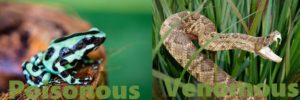Red-back salamanders (also called redback salamanders) are common across the eastern and central United States. These salamanders are usually found in forest areas but often wander into people’s backyards. You may have seen one of these salamanders and wondered if they are poisonous.
Red-backed salamanders are very mildly poisonous. They have glands that secrete a milky toxin as a defense against predators. However, this toxin is extremely mild and only has the effect of making the salamander foul-tasting to any animal that tries to eat it.
Red-backed salamanders are otherwise harmless creatures. Just practice a sufficient level of hygiene (they can be carriers of salmonella), and you will be fine.
About the Red-Backed Salamander
Although these salamanders are called “red-backed”, not all of them have the color red on their backs. They have many color variations but mainly occur in two color morphs: The lead-back, and the red-back morph you are more familiar with.
The red-back morph has a broad straight stripe from the head, extending to the tip of its tail. The stripe is usually red, but may also be yellow or orange. The lead-back morph, on the other hand, lacks the red stripe. It has a purely grey to black color on its back instead.
These color morphs are usually related to elevation. Salamanders that live in higher elevations tend to have the red-back morph, while salamanders in lower elevations tend to have the lead-back morph.

Regardless of morph, red-backed salamanders are very small, measuring only 2-4 inches, making them a potential meal for any animal that can fit them into its mouth. This means they need a way to defend themselves.
Their first line of defense is their ability to detach the tail from the rest of the body. While the predator is still distracted by the tail wiggling on the ground, the salamander can escape. (The salamander is not harmed by this, and its tail regrows in a few weeks).
As a second line of defense, red-backed salamanders can secrete a milky toxic secretion that makes them taste bad to predators.
Red-Backed Salamanders Are Only Very Mildly Poisonous
Red-backed salamanders only have an extremely mild toxin, to the point where it has no noticeable effect on most predators apart from giving the salamander a slightly foul taste. Due to this, these salamanders are still on the menu for lots of predators.
That said, you should know that there is a difference between a poisonous animal and a venomous one. Most people use these terms almost interchangeably, but there are some differences between them.
- If an animal has to bite or sting you to inject its toxins, it is venomous (think rattlesnakes)
- If an animal secretes its toxin on its skin, and you absorb that toxin when you touch the animal, it is poisonous (think poison dart frogs).

In this way, rattlesnakes, scorpions, and many spiders are venomous, while many frogs, newts, and salamanders (including the red-backed salamander) are only poisonous.
Are Red-Backed Salamanders Dangerous to Humans?
Salamanders Can Be Carriers of Salmonella
Also, most amphibians, including the red-backed salamander can carry salmonella bacteria in their intestines and shed them off in their feces. The bacteria do make the salamander sick but can cause serious illness in humans.

You can be exposed to salmonella by touching the salamander, its feces, or any object the salamander has come in contact with.
Humans exposed to salmonella can get an infection called Salmonellosis characterized by diarrhea, fever, and abdominal cramps. Although this infection is usually non-life-threatening, it can spread to the bloodstream or nervous system leading to severe illness.
For this reason, it is advisable to avoid handling salamanders frequently. Only handle them when necessary, and when you do, observe good hygiene and wash your hands with anti-bacterial soap before touching anything else.
Are Red-Backed Salamanders Dangerous to Dogs, Cats, or Other Pets?
Since red-backed salamanders are only very mildly poisonous, it is highly unlikely that their toxin will be a danger to dogs, cats, or most other household pets. However, these can be dangerous to pets in other ways.
Like humans, dogs and other pets can be exposed to salmonella through contact with salamanders.
In addition, salamanders can carry tapeworms, flukes, and other parasites in their bodies. If a dog (or cat) were to eat a red-backed salamander, there is a possibility it will also consume parasites and develop a parasitic infection.
For this reason, it is a good idea to keep your pets away from salamanders. Even the ones that are not lethally toxic can harm your pet in other ways.
If you have pet salamanders at home, keep them in a secure enclosure so they do not come in contact with any of your other pets.
How to Safely Handle a Red-Backed Salamander
Generally, it is not a good idea to handle amphibians. This is because they have a very sensitive permeable skin that absorbs water and other substances it comes in contact with.
If you touch a salamander, lotions, perfumes, repellents, and other substances on your hands can be absorbed right through its skin, and hurt, or even potentially kill the salamander.
For this reason, you should only handle salamanders when necessary. When you do, take these precautions to protect both you and the salamander.
Before Handling:
- Make sure your hands are clean. Not just clean from dirt, but clean from dirt but washed off so thoroughly that no residue of soap or any other potentially harmful substances remain
After Handling:
- Wash your hands with anti-bacterial soap
- Before washing, do not touch your eyes, mouth, or anything for that matter, as you could spread the bacteria around and make them harder to get rid of.
With these simple precautions, red-backed salamanders can be totally harmless.
Frequently Asked Questions
Question: Can You Keep a Red-Backed Salamander as a Pet?
Answer: Different states have different laws regarding which salamanders can be kept as pets (check the laws of your state to see which salamanders are illegal to own). If it is legal to own a red-backed salamander in the area you live in, you can certainly keep one as a pet.
However, these salamanders are quite rare in the pet trade, so red-backed salamanders kept as pets are typically wild-caught; which is not advisable, and may even be illegal in some places.
Question: What Do Red-Backed Salamanders Eat?
Answer: Like all salamanders, red-backs are strict carnivores, which means they only eat animal protein. In the wild, they eat ants, mites, spiders, and other small bugs they can find. When kept in captivity, they are usually fed pinhead crickets and other small bugs.
Question: Can Red-Backed Salamanders Breathe Underwater?
Answer: Red-backed salamanders are fully terrestrial for their entire life. They do not have adaptions to survive in an aquatic environment and cannot breathe underwater (although most salamanders can).
Final Thoughts
Red-backed salamanders are generally very harmless creatures. The only real threat they pose is that they can be carriers of salmonella, which can be transmitted to humans if proper hygiene is not followed.
When handled with proper care and hygiene, these salamanders are nothing to be worried about.


